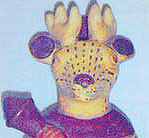
Like China, Peru in South America boasts one of the earliest civilizations on earth, dating back some thousands of years.
It takes time and effort to visit Peru, since it lies on the other side of the Pacific Ocean, hidden amongst Amazonian jungle and the Andes mountains.
But an ongoing exhibition on Peru held at the China National Museum until November 2 has brought the country much closer to Beijingers.
The exhibition on Peru's Millenarian Culture, sponsored by the Ministry of Culture of China, was organized by the Embassy of Peru in China and the museum (Tel: 6512-8321).
On display are some 80 replicas of Peruvian ceramics created between 1,250 BC, when civilizations first emerged in the area, and 1,400 AD, when the Inca empire was all-powerful.
An exhibition by Martin Chambi, a photographer of Indian descent, is also on show.
"We hope that Beijingers will enjoy a multifaceted view of the cultures and societies in Peru, both of ancient and modern times," said Huang Yucheng, who is in charge of the exhibition at the museum.
The opening of the exhibition on Monday afternoon was attended by Chinese and Peruvian officials and diplomats, including first lady Eliane Karp de Toledo.
"We feel proud that we are displaying some part of our great culture here in China, although this is only a small part of that great heritage," Toledo said at the launch. An anthropologist, she happened to be in China to discuss some issues in the field with her Chinese counterparts.
Combing through the primitive but colorful ceramic works, one cannot help but marvel at the talent and skills displayed in the handicrafts of the ancient Peruvians.
The ceramic works selected represent the dozen different cultures that preceded the Inca empire. They include the Moches culture which existed on the northern coast, and the Nazca culture (200-700 AD) which developed in the southern deserts of Peru.
If one examines these ceramics closely enough, one finds that many are exotic, open and filled with hope and humor. There are nude figures of men and women, mini-sculptures of love-making and breast-feeding and the shapes of birds, frogs and sharks. They also depict holy or mythical images such as creatures that are half-crab, half-man and a snake with two cat-like heads.
Most of the ceramics are colorful, but do not include blue and green. This is because blue and green represent the sea, which the ancient Peruvians worshipped.
Besides the ceramics, an exhibition of black-and-white photos taken by Chambi (1891-1973) is also being held. The photos record all classes of Peruvian society in the cultural center of Cusco from the 1920s until the 1950s. Chambi stopped taking photos when a sudden earthquake destroyed Cusco, burying the source of his inspiration.
Born into a humble farmer's family, Chambi was the first major Latin American photographer of Indian descent. He is considered the first "to look at his people with eyes that had never been colonized." The old photos, though shot in black and white with few finishing touches, have an inner strength and power.
"Like everyone attending the exhibition here, we are proud of our long history and ancient civilizations..." Toledo said.
"We believe such cultural communication is the best way to bring our peoples much closer, and we hope that this event is just the beginning of a chain of exhibitions."
(Beijing Weekend October 31, 2003)
|

